Fluid Dynamics, Multi Phase Flow, and Thermal Recovery Methods
A special issue of Processes (ISSN 2227-9717). This special issue belongs to the section "Chemical Processes and Systems".
Deadline for manuscript submissions: closed (31 January 2021) | Viewed by 53166
Special Issue Editors
Interests: drying; fluid and species transport in porous materials; thermochemical processes; characterization of porous materials; particle technology
Special Issues, Collections and Topics in MDPI journals
Interests: fluid flow through porous media; mathematical and numerical modeling; polymer flooding; in-situ foam generation; carbon sequestration and adsorption; chemical enhanced oil recovery; thermal recovery; heat transfer
Special Issue Information
Dear Colleagues,
It is essential to have an adequate understanding of the fluid structure in porous media, since this gives direct information about the processes necessary to extract the liquid, as well as the likely yield. On the other hand, the direct visualization of porous media is challenging, and so the development of microfluidic analogues is particularly useful since this means that such systems can be studied in the laboratory. One microfluidic property is the delivery of the liquid rapidly by the exploitation of the impacts of surface tension, encoded by the microchannel’s surface chemistry and geometry. More widely, microfluidic systems have become more popular because of their high reaction rate, reduction of reagent consumption, and the possibilities for mass production. Moreover, in order to develop accurate models for heat and mass transfer applications involving fluid flow in geothermal applications or reservoir engineering and petroleum industries, a basic knowledge of the rheological and transport properties of the materials (e.g., reservoir characteristics especially in high-temperature and high-pressure environments) are needed. In this Special Issue, all aspects of fluid flow and heat transfer in geothermal applications, including the ground heat exchanger, conduction and convection in porous media, and industrial purposes will be considered. Furthermore, thermal-heat recovery, also called waste-heat recovery uses heat energy released from some industrial processes that would otherwise dissipate into the immediate environment unused.
This Special Issue on Fluid Dynamics, Multi Phase Flow, and Thermal Recovery Methods aims to curate novel advances in the development and application of computational modeling to address longstanding challenges for industrial purposes. All types of research approaches are equally acceptable: computational fluid dynamics, carbon capture and sequestration, experimental investigation, theoretical and numerical simulation, and their mixtures. The papers can be either fundamental or applied engineering sciences, including industrial case studies. With such a wide brief, it is naturally very difficult to define a finite list of relevant disciplines.
Dr. Abdolreza Kharaghani
Afshin Davarpanah
Guest Editors
Manuscript Submission Information
Manuscripts should be submitted online at www.mdpi.com by registering and logging in to this website. Once you are registered, click here to go to the submission form. Manuscripts can be submitted until the deadline. All submissions that pass pre-check are peer-reviewed. Accepted papers will be published continuously in the journal (as soon as accepted) and will be listed together on the special issue website. Research articles, review articles as well as short communications are invited. For planned papers, a title and short abstract (about 100 words) can be sent to the Editorial Office for announcement on this website.
Submitted manuscripts should not have been published previously, nor be under consideration for publication elsewhere (except conference proceedings papers). All manuscripts are thoroughly refereed through a single-blind peer-review process. A guide for authors and other relevant information for submission of manuscripts is available on the Instructions for Authors page. Processes is an international peer-reviewed open access monthly journal published by MDPI.
Please visit the Instructions for Authors page before submitting a manuscript. The Article Processing Charge (APC) for publication in this open access journal is 2400 CHF (Swiss Francs). Submitted papers should be well formatted and use good English. Authors may use MDPI's English editing service prior to publication or during author revisions.
Keywords
- Fluid dynamics
- Carbon capture and storage
- Integrated microfluidic devices
- Thermal methods
- Exergy analysis
- Multi-phase flow
- Mathematical modeling
- Foams application
- Polymers
- Thermal-heat recovery
Benefits of Publishing in a Special Issue
- Ease of navigation: Grouping papers by topic helps scholars navigate broad scope journals more efficiently.
- Greater discoverability: Special Issues support the reach and impact of scientific research. Articles in Special Issues are more discoverable and cited more frequently.
- Expansion of research network: Special Issues facilitate connections among authors, fostering scientific collaborations.
- External promotion: Articles in Special Issues are often promoted through the journal's social media, increasing their visibility.
- Reprint: MDPI Books provides the opportunity to republish successful Special Issues in book format, both online and in print.
Further information on MDPI's Special Issue policies can be found here.






